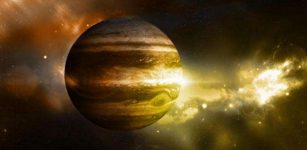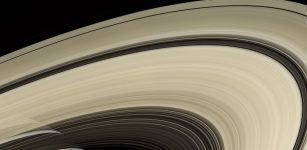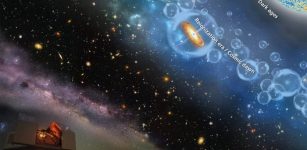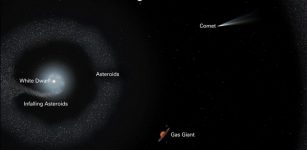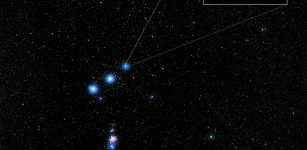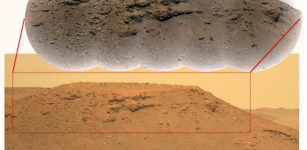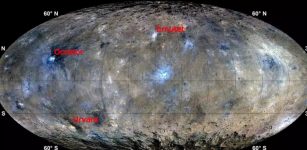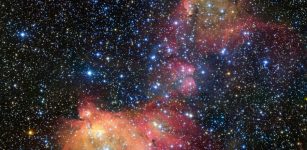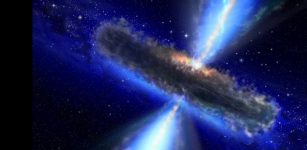Black ‘Sand-Like’ Dust And Soil Found In Box That Returned From Asteroid Ryugu
Eddie Gonzales Jr. – MessageToEagle.com – The Japan Aerospace Exploration Agency (JAXA) confirmed that samples from asteroid Ryugu have been collected within the sample container inside the re-entry capsule of the asteroid explorer, Hayabusa2.
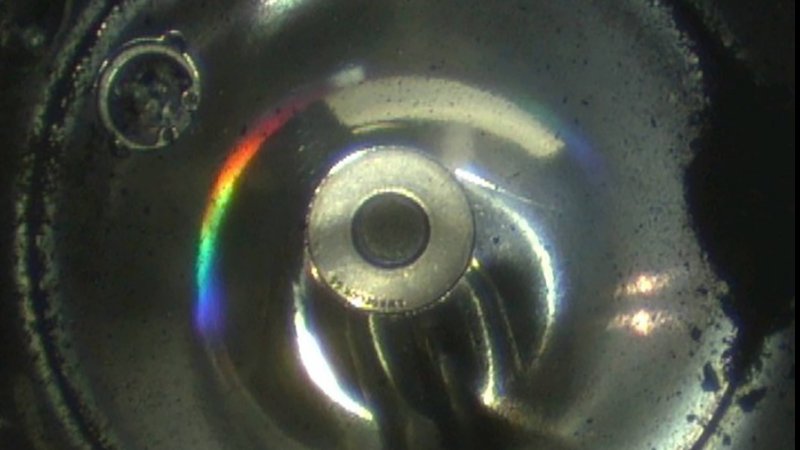 Image of the inside of the sample container, taken with the scope camera. Sand grains believed to be from the asteroid Ryugu were found in the capsule brought back by the spacecraft Hayabusa2. | JAXA / VIA AFP-JIJI
Image of the inside of the sample container, taken with the scope camera. Sand grains believed to be from the asteroid Ryugu were found in the capsule brought back by the spacecraft Hayabusa2. | JAXA / VIA AFP-JIJI
The Hayabusa2 re-entry capsule was recovered in Woomera, Australia on December 6, 2020 and delivered to the JAXA Sagamihara Campus on December 8.
Work then began to open the sample container inside the re-entry capsule. Scientists confirmed that black sandy dust was found in a capsule brought to Earth by a Japanese space probe. The black dust originates from the distant asteroid Ryugu.
JAXA (Japan Aerospace Exploration Agency) released a picture of a small deposit of sooty material inside the metal box — a first glimpse at the results of an unprecedented six-year mission for the unmanned probe.
The dust was found in the capsule’s outer shell, agency officials said, with more substantial samples expected to be found when they open the inner container, a delicate task.
 Equipment for gas analysis brought to the Woomera Local Headquarters in Australia. Image credit: JAXA
Equipment for gas analysis brought to the Woomera Local Headquarters in Australia. Image credit: JAXA
“JAXA has confirmed that samples derived from the asteroid Ryugu are inside the sample container,” the agency said, adding that black, sand-like particles which are believed to be derived from the asteroid Ryugu.
At a news conference Tuesday, JAXA researcher Hirotaka Sawada said he was speechless when he first glimpsed the samples and they were better than hoped for.
“We were aiming for 100 mg or more, and we definitely got that,” Sawada said. “It was really different from what I expected, there was a fair amount.”
Hayabusa2 traveled about 300 million kilometers from Earth to collect the samples, which scientists hope could help shed light on the origin of life and the formation of the universe. The probe collected both surface dust and pristine material from below the surface that was stirred up by firing an “impactor” into the asteroid.
 The capsule was retrieved on Sunday in a desert in southern Australia. Image source
The capsule was retrieved on Sunday in a desert in southern Australia. Image source
“We will continue our work to open the sample-catcher within the sample container. Extraction of the sample and analysis of it will be carried out,” JAXA said.
Half of Hayabusa2’s samples will be shared between JAXA, U.S. space agency NASA and other international organizations, and the rest kept for future study as advances are made in analytic technology. The probe will now begin an extended mission targeting two new asteroids.
In a press release dated Dec. 15, 2020, JAXA confirmed that the gas collected from the sample container inside the re-entry capsule of the asteroid explorer, Hayabusa2, is a gas sample originating from asteroid Ryugu.
The result of the mass spectrometry of the collected gas within the sample container performed at the QLF (Quick Look Facility) established at the Woomera Local Headquarters in Australia on December 7, 2020, suggested that the gas differed from the atmospheric composition of the Earth.
For additional confirmation, a similar analysis was performed on December 10 – 11 at the Extraterrestrial Sample Curation Center on the JAXA Sagamihara Campus. This has led to the conclusion that the gas in the sample container is derived from asteroid Ryugu.
The grounds for making this decision are due to the following three points.
- Gas analysis at the Extraterrestrial Sample Curation Center and at the Woomera Local Headquarters in Australia gave the same result.
- The sample container is sealed with an aluminum metal seal and the condition of the container is as designed, such that the inclusion of the Earth’s atmosphere was kept well below the permissible level during the mission.
- Since it was confirmed on the Sagamihara campus that gas of the same composition had been generated even after the removal of the container gas in Australia, it is considered that the collected gas must be due to the degassing from the sample.
This is the world’s first sample return of a material in the gas state from deep space.
The initial analysis team will continue by opening the sample container and performing a detailed analysis of the molecular and isotopic composition of the collected gas.
Written by Eddie Gonzales Jr. – MessageToEagle.com Staff


